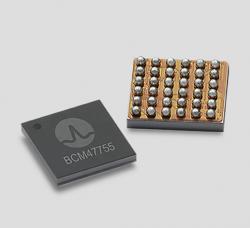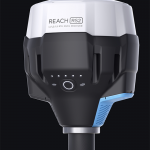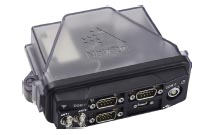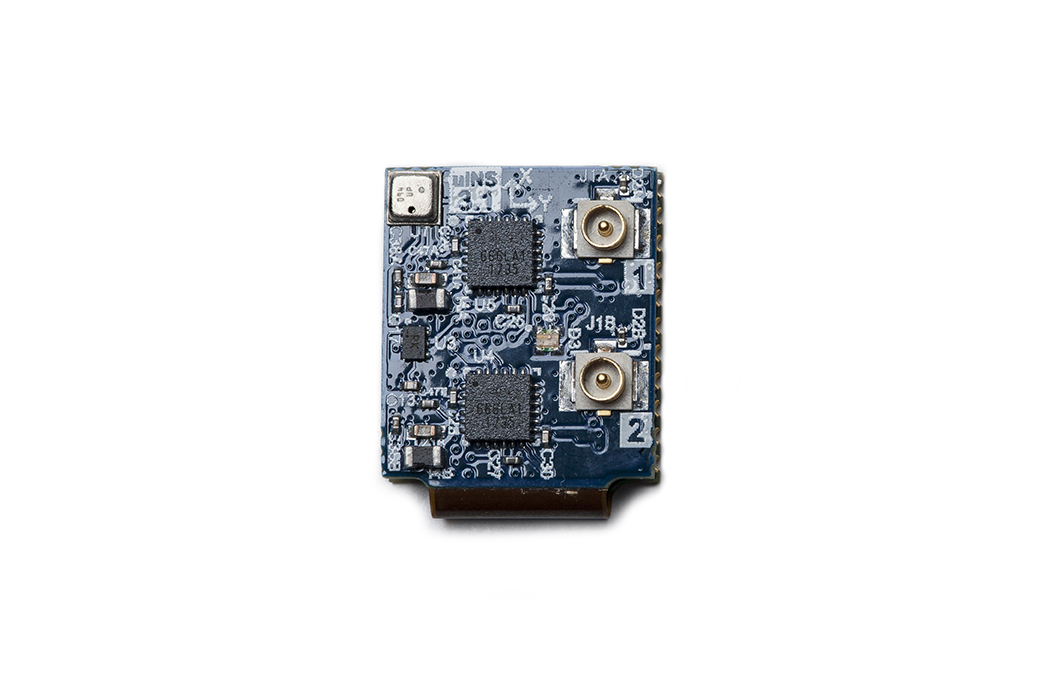 The BCM47755 is designed to enhance LBS applications for mobile phones, tablets and fitness wearables. Photo: Broadcom Ltd.
The BCM47755 is designed to enhance LBS applications for mobile phones, tablets and fitness wearables. Photo: Broadcom Ltd.No longer will a high-end, expensive GNSS receiver be required to achieve centimeter accuracy now that Broadcom Limited has announced the launch of its new dual-frequency receiver with such accuracy designed for consumer location-based services (LBS) applications.
No longer will a high-end, expensive GNSS receiver be required to achieve centimeter accuracy now that Broadcom Limited has announced the launch of its new dual-frequency receiver with such accuracy designed for consumer location-based services (LBS) applications.
Broadcom, a designer, developer and global supplier of a broad range of digital and analog semiconductor connectivity solutions, today announced the world’s first mass-market, dual-frequency GNSS receiver device, the BCM47755, designed to enhance LBS applications for mobile phones, tablets and fitness wearables. Equipped with the latest GNSS innovations, the device is capable of centimeter accuracy with minimal power consumption and footprint, enabling an entirely new suite of high-precision LBS applications including lane-level vehicle navigation and mobile augmented reality (AR).
Until now, mobile location-based applications have been powered by single-frequency GNSS receivers operating under stringent battery power and footprint constraints, according to Broadcom. The expanded availability of L1/E1 and L5/E5 frequencies in satellite constellations enables the use of two frequencies to compute position much more accurately in both urban and open area environments.
“The beauty of this is of course you have more constellations for your computations,” Manuel del Castillo, Broadcom’s associate director, GNSS product marketing, told Inside GNSS. “So, you can be potentially be in an urban area with a small, narrow corridor where you have limited visibility of the sky and the more satellites you have the better. Multi constellations is something that we started at Broadcom and we never dropped.”
del Castillo said the BCM47755 receiver supports GPS, GLONASS, BeiDou, Galileo and QZSS, but what also makes this a breakthrough is its dual-frequency capabilities and it’s mass market availability.
“This is the first time that we bring the dual-frequency feature to the mass market. This is pretty revolutionary in the sense that this centimeter accuracy can now be achieved on a smartphone with the mass market components of the smartphone and the price of the smartphone,” he said.
The BCM47755 delivers this higher level of location accuracy while meeting the rigorous battery power and footprint needs in mobile phones. According to the company, this new receiver uses half the power used by the previous generation chip.
The BCM47755’s accuracy allows location-based applications to offer a richer consumer experience. For example, lane-level knowledge of the vehicle’s location vastly improves the turn-by-turn navigation performance. Further, combining this accurate location with the lane’s traffic pattern gives consumers a significantly better estimate of arrival times. In the same vein, ride hailing applications can be enhanced to more precisely pinpoint driver and client location.
Since GNSS and sensor applications are always on, the new receiver’s power efficiency has a proportional impact on the battery life of the mobile device. So, even while benefiting from a richer navigation experience, consumers will have a longer lasting battery on mobile devices that use the BCM47755, del Castillo said.
“Our focus is on smartphones and watches,” del Castillo added. “This is a high-end GNSS chip and initially it should go in flagship smartphones. Eventually it will move itself down to other smartphones, and we’ll open our focus to other industries like automotive, and maybe other smart devices like IoT (Internet of Things).”
The company didn’t share specifics on costs, but did note that it is designed to be included in smartphones for the mass market.
“We can just say that the cost is in line with previous generation chips otherwise we would not be able to go to a smartphone,” del Castillo said. “So, it is disruptive in technology but it is not disruptive in price, really. We have been able to pack that same technology in a smaller construction geometry.”
Product Highlights
• Advanced dual-frequency GNSS receiver capable of processing satellite signals in both L1/E1 and L5/E5 frequency bands providing higher level of location accuracy
• Incorporates new low power GNSS radio and dual-core ARM CM4-CM0 sensor hub
• More than 50% lower power consumption compared to previous generation GNSS receiver
• Delivers high quality raw GNSS measurements for both code and carrier phase enabling advanced location-based applications
“With the launch of the dual-frequency GNSS sensor hub, Broadcom continues the tradition of raising the bar for mobile GNSS,” said Vijay Nagarajan, senior director of product marketing of the Mobile Connectivity Products Division at Broadcom. “Location-based consumer applications can be disruptively enhanced with centimeter-level accuracy. On the other hand, lower power consumption and smaller footprint continue to be defining requirements for any mobile phone chip. The BCM47755 achieves these twin objectives for a richer consumer experience.”
“An important technical milestone has been reached with the addition of the L5 frequency band,” said Samuel McLaughlin, research analyst at ABI Research, in a press release announcing the launch on Sept. 21. “As smartphones incorporate this technology, developers can make use of lane-level location information to enable exciting, new applications. Our research shows that currently over 90% of automotive navigation systems are handset-based as opposed to dedicated systems such as personal navigation devices, and Broadcom’s new BCM47755 chipset is well poised to take advantage of this industry shift.”
“We optimized the design of Galileo for dual frequency services,” said Javier Benedicto, Galileo project manager at the European Space Agency. “The availability of mass-market chips processing Galileo E1/E5 will allow users to experience Galileo at its best.”
“We are glad to see the industry recognizing the advantages of dual-frequency GNSS receivers, including Galileo E1 and E5,” said Carlo des Dorides, executive director of European GNSS Agency, Galileo market development. “We believe Galileo’s contribution is instrumental to reach mass market GNSS centimeter level accuracy.”
Availability
The company said it planned this launch leading up to ION GNSS+ (September 25-29 at the Oregon Convention Center in Portland, Oregon). Broadcom is currently sampling the BCM47755 dual frequency GNSS receiver to its early access partners and customers. Additionally, Broadcom will be presenting further information on the BCM47755 in the Ubiquitous Navigation panel at the ION GNSS+ 2017 on September 27, 2017.

![Trimble Introduces High-Accuracy OEM GNSS<br>Receiver Module for Industrial Autonomy Applications Trimble_BD9250_right v03[17]](https://insidegnss.com/wp-content/uploads/2022/05/Trimble_BD9250_right-v0317-150x150.jpg)



